Fertile Crescent › The Eternal Life of Gilgamesh » Origins and History
Articles and Definitions › Contents
- Fertile Crescent › Ancient History
- The Eternal Life of Gilgamesh › Antique Origins
Ancient civilizations › Historical places, and their characters
Fertile Crescent › Ancient History
Definition and Origins
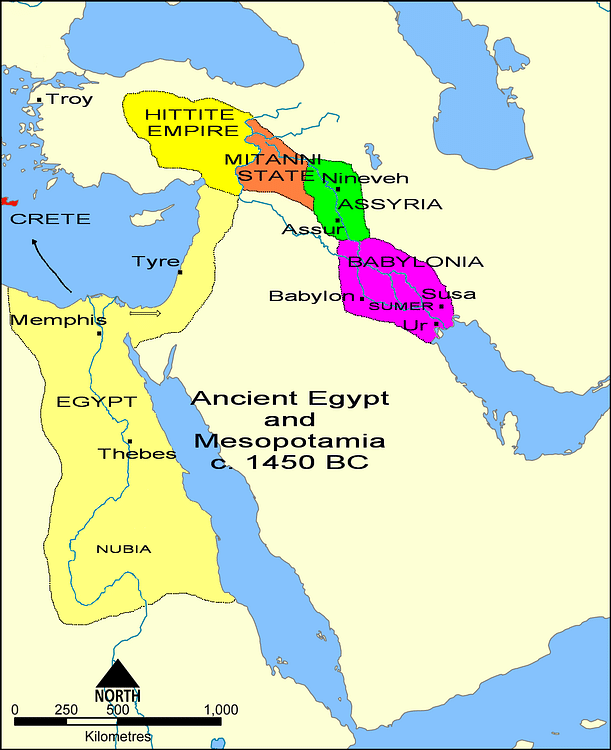
The Fertile Crescent, often called the "Cradle of Civilization ", is the region in the Middle East which curves, like a quarter-moon shape, from the Persian Gulf, through modern-day southern Iraq, Syria, Lebanon, Jordan, Israel and northern Egypt.The region has long been recognized for its vital contributions to world culture stemming from the civilizations of ancient Mesopotamia, Egypt, and the Levant which included the Sumerians, Babylonians, Assyrians, Egyptians, and Phoenicians, all of whom were responsible for the development of civilization.
Virtually every area of human knowledge was advanced by these people, including:
- Science and Technology
- Writing and Literature
- Religion
- Agricultural Techniques
- Mathematics and Astronomy
- Astrology and the Development of the Zodiac
- Domestication of Animals
- Long-Distance Trade
- Medical Practices (including dentistry)
- The Wheel
- The Concept of Time
The term was first coined in 1916 CE by the Egyptologist James Henry Breasted in his work Ancient Times: A History of the Early World, where he wrote:
This fertile crescent is approximately a semi-circle, with the open side toward the south, having the west end at the south-east corner of the Mediterranean, the centre directly north of Arabia, and the east end at the north end of the Persian Gulf. (193-194)
His phrase was widely circulated through the publications of the day becoming, finally, the common designation for this region.The Fertile Crescent is traditionally associated in the Jewish, Christian and Muslim faiths with the earthly location of the Garden of Eden. The area features prominently in the Bible and Quran and a number of sites there are associated with narratives from those works.
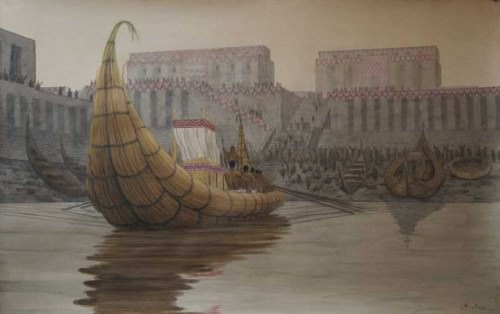
Representation of the Port of Eridu
CRADLE OF CIVILIZATION
Known as the Cradle of Civilization, the Fertile Crescent is regarded as the birthplace of agriculture, urbanization, writing, trade, science, history and organized religion and was first populated c. 10,000 BCE when agriculture and the domestication of animals began in the region. By 9,000 BCE the cultivation of wild grains and cereals was wide-spread and, by 5000 BCE, irrigation of agricultural crops was fully developed. By 4500 BCE the cultivation of wool-bearing sheep was practiced widely.
THE GEOGRAPHY & CLIMATE OF THE REGION WERE CONDUCIVE TO AGRICULTURE & HUNTER-GATHERER SOCIETIES SHIFTED TO SEDENTARY COMMUNITIES.
The geography and climate of the region were conducive to agriculture and hunter-gatherer societies shifted to sedentary communities in the area as they were able to support themselves from the land. The climate was semi-arid but the humidity, and proximity of the Tigris and Euphrates Rivers (and, further south, the Nile ), encouraged the cultivation of crops. Rural communities developed along with technological advances in agriculture and, once these were established, domestication of animals followed.
The first cities began to rise in Mesopotamia in the region of Sumer. Eridu, the first, according to the Sumerians, in 5400 BCE, then Uruk and others. By c. 4500 BCE cultivation of wheat and grains had long been practiced in addition to the further domestication of animals. By the year 3500 BCE the image of the breed of dog known as the Saluki was appearing regularly on vases and other ceramics as well as wall paintings along with breeds such as the Dane, Greyhound, and Mastiff.
The unusually fertile soil of the region encouraged the further cultivation of wheat as well as rye, barley, and legumes and some of the earliest beer in the world was brewed in the great cities along the Tigris and Euphrates Rivers under the auspices of the goddess Ninkasi. Beer was considered a gift from the gods and a source of daily nutrition as well as an intoxicant. It was used to pay people's wages but inscriptions also make clear it was brewed for celebratory purposes and the famous Hymn to Ninkasi praises the brew for making one's heart feel light.
This beer was quite different from that of the modern day as it was thick and had to be consumed with a straw to filter out residue from the fermenting process. Beer brewing probably evolved from the baker's craft as the barley and wheat they stored fermented. The most ancient evidence of beer brewing comes from the Sumerian outpost settlement of Godin Tepe in modern-day Iran.
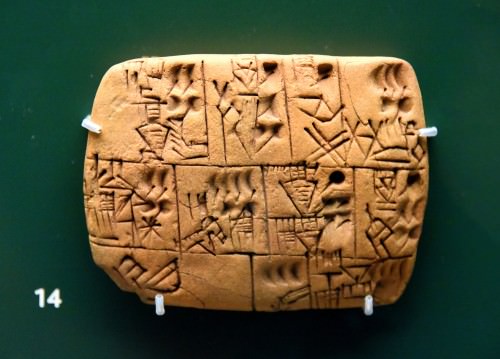
Mesopotamian Beer Rations Tablet
Emmer wheat, barley, chickpeas, lentils, and many other crops were planted, harvested, and sent to the temples where food supplies were stored. From c. 3400 BCE, the priests of the temple complexes were responsible for the distribution of food and the careful monitoring of surplus for trade.
TRADE & EMPIRE
Trade routes grew up to form long-distance travel to the Kingdom of Saba in southern Arabia, Egypt, and the Kingdom of Kush in Africa. In time, this trade would establish the so-called Incense Routes which flourished between the 7th/6th centuries BCE and the 2nd century CE. The Incense Routes would facilitate cross-cultural exchange as merchants would carry innovations in various branches of knowledge along with their goods.
By 2300 BCE, soap was produced from tallow and ash and was in wide use as personal hygiene was valued in relation to one's standing with one's community and to honor the gods. Attention to one's person in terms of hygiene was stressed in that human beings were thought to have been created as help-mates to the gods and so should make themselves presentable in the performance of their duties.
As in Egypt, ritual bathing and personal grooming were especially important for the clergy. Those who attended to the gods were held to an even higher standard but, even for the most common laborer, cleanliness and grooming were important values. Artifacts from the region attest to this as mirrors, cosmetic jars, combs, hair brushes, and toothbrushes have been found as well as artistic depictions of bathing and inscriptions stressing its importance.
FROM 1900-1400 BCE TRADE WITH EUROPE, EGYPT, PHOENICIA & THE INDIAN SUB-CONTINENT WAS FLOURISHING.
The people of the region lived in separate urban city -states until the rise of the first multi-cultural empire in the world: Akkad.From 2334-2279 BCE Sargon of Akkad ( Sargon the Great ) ruled over Mesopotamia, allowing for the growth of great building projects, artworks, and religious literature such as the hymns to Inanna by Sargon ’s daughter, Enheduanna (2285-2250 BCE), the first author in the world known by name.
By 2000 BCE, Babylon controlled the Fertile Crescent and the region saw advances in law ( Hammurabi ’s famous code), literature ( The Epic of Gilgamesh, among other works), religion (the development of the Babylonian pantheon of the gods), science (astronomical measurements and technological developments), and mathematics.
From 1900-1400 BCE trade with Europe, Egypt, Phoenicia and the Indian sub-continent was flourishing, resulting in the spread of literacy, culture and religion to these regions. The goddess Nisaba, patroness of writing, grains, literacy, and wisdom, became known and worshipped in regions far from her native Sumer. Mesopotamian beer was a valued commodity in trade and many of the most important Mesopotamian deities traveled to other regions along the trade routes.
THE PROMISED LAND
It is speculated that it was in either 1900 or c. 1750 BCE that the biblical patriarch Abraham left his native city of Ur for the 'promised land' of Canaan carrying the tales and legends of Mesopotamian gods with him which would in time appear, transformed, as biblical narratives. If it was not in fact Abraham who diffused Mesopotamian myth and legend it was certainly someone like him. It is clear the parallels between stories such as the Mesoptamian Atrahasis and Noah's Flood, and the Myth of Adapa and the Book of Genesis' tale of the Fall of Man, among many others, share significant similarities.
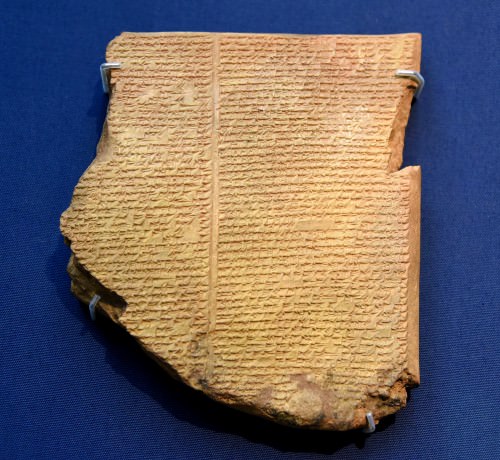
Flood Tablet of the Epic of Gilgamesh
Prior to the mid-19th century CE, the Bible was considered the oldest book in the world and the stories it contained were thought to be original pieces written by God or God-inspired. After archaeological digs in the region of the Fertile Crescent, however, and the discovery of the Sumerian civilization, it became clear that biblical narratives were derived from earlier Mesopotamian works. Mesopotamian religion and literature, in fact, would inspire and inform that of many other later cultures.
CHANGING EMPIRES
The region changed hands many times through the ages. By 912 BCE the Assyrians controlled the Fertile Crescent and developed their vast empire. The Neo-Assyrian Empire was ruled by some of the best-known kings from antiquity including Tiglath Pileser III (745-727 BCE), Sargon II (722-705 BCE), Sennacherib (705-681 BCE), Esarhaddon (681-669 BCE) and Ashurbanipal (668-627 BCE). Ashurbanipal prized knowledge highly and ordered all the literary works of the region copied and stored in his great library.
When the Neo-Assyrian Empire fell in 612 BCE, the invading forces set fire to the libraries of the cities but, since the works were written on clay tablets, they were only baked harder, not destroyed. The invaders, inadvertently, were responsible for the preservation of the very culture they sought to destroy.
By 580 BCE, the Neo-Babylonian Chaldean Empire under Nebuchadnezzar II (634-562 BCE) was in power and Babylon flourished as the greatest city on earth. Allegedly, at this time, Nebuchadnezzar had the famous Hanging Gardens of Babylon created for his wife to remind her of her homeland. In 539 BCE Babylon fell to Cyrus the Great (d. 530 BCE) after the Battleof Opis and the lands fell under the control of the Achaemenid Empire, also known as The First Persian Empire.
Alexander the Great invaded the area in 334 BCE and, after him, it was ruled by the Parthians, among others, until the coming of Rome in 116 CE. After the short-lived Roman annexation and occupation, the region was conquered by the Sassanid Persians (c. 226 CE) and, finally, by the Arabian Muslims in the 7th century CE.
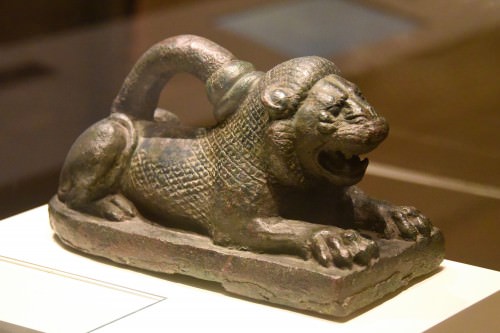
Achaemenid Lion Weight
By this time the glorious achievements of the early cities which grew up beside the Tigris and Euphrates Rivers had long been disseminated throughout the ancient world but the cities themselves were mostly in ruins through the destruction caused by the many military conquests in the region as well as natural causes such as earthquakes and fire. Rampant urbanization and the over-use of the land also resulted in the decline and eventual abandonment of the cities of the Fertile Crescent.
BABYLON'S NAME WOULD FOREVER BE LINKED TO SIN & CORRUPTION BY THE LATER HEBREW SCRIBES.
The city of Eridu, considered by the early Mesopotamians to be the first city on earth, built and inhabited by the gods, had been abandoned since 600 BCE, Uruk, the city of Gilgamesh, since 630 CE and Babylon, the city known for high culture, writing, law, science, and all manner of learning in the ancient world was a vacant ruin. Babylon's name would forever be linked to sin and corruption by the later Hebrew scribes who wrote the biblical narratives but, in its time, was greatly respected as a center of learning and civilization.
THE FERTILE CRESCENT TODAY
In 2001 CE the National Geographic News reported that the Fertile Crescent was rapidly becoming so only in name as, due to extensive damming of the rivers as well as a massive draining works program initiated in southern Iraq from the 1970's CE on, the fertile marshlands which once covered 15,000 – 20,000 square kilometers (5,800 – 7,700 square miles) had shrunk to a mere 1,500 – 2,000 square kilometers (580 – 770 square miles).
As pleas from environmental groups and regional farmers to stop damming and drainage projects were ignored by the governments of Iraq, Syria, and Turkey, the situation worsened so that, presently, the region which once was the lush paradise and cradle of civilization largely consists of dry, cracked plains of sun-baked clay.
Even after continued, long-term, threats to the environment were made clear to the governments of the region, no substantial efforts were made to preserve the land or reverse the damage. It has been observed by many scholars, historians, environmentalists, and writers through the centuries that human beings fail to learn from their pasts - whether individually or collectively. The philosopher George Santayana famously noted that "those who cannot remember the past are condemned to repeat it" and this paradigm rings as true for the Fertile Crescent as it does for any other region in the world today.
The Eternal Life of Gilgamesh › Antique Origins
Ancient Civilizations
The Epic of Gilgamesh is among the most popular works of literature in the present day and has influenced countless numbers of readers but, for the greater part of its history, it was lost. The Assyrian Empire fell to a coalition of Babylonians and Medes in 612 BCE who sacked and burned the Assyrian cities and, among them, Nineveh.
Nineveh was the great capital where the king Ashurbanipal (668-627 BCE) had established his library which housed copies of every literary work he could find throughout Mesopotamia. As these works were written in cuneiform on clay tablets, however, the fires which consumed the library did nothing to the tablets but to bake them. Even so, the buildings which housed these works were destroyed, burying the literature of Mesopotamia beneath them for over 2,000 years until they were re-discovered in the mid-19th century CE.

Flood Tablet of the Epic of Gilgamesh
At this time, European antiquarian societies, museums, governments, and other institutions sent archaeologists to Mesopotamia in the interest of finding physical evidence which would corroborate narratives in the Bible. Since Mesopotamian sites and kings were so frequently mentioned throughout the Old Testament, it was thought that a concerted effort in excavation would prove the narratives true. This was especially important at this time as Darwin's work had been gaining in popularity since its publication in 1859 CE and people were questioning the authority of the Bible.
THE MESOPOTAMIAN EXCAVATIONS OF THE 19TH CENTURY CE LITERALLY CHANGED WORLD HISTORY BECAUSE NOW IT WAS UNDERSTOOD THAT THE BIBLE WAS NOT THE OLDEST BOOK IN THE WORLD.
What these excavators discovered was actually the exact opposite of what they were sent to find. As they uncovered the cities of Mesopotamia, they also uncovered the ancient texts which, once deciphered, clearly showed that some of the most famous stories in the Bible - the Fall of Man, the Great Flood and Noah's Ark - were later versions of Sumerian myths and legends.
The Mesopotamian excavations of the 19th century CE literally changed world history because now it was understood that the Bible was not the oldest book in the world, that civilizations had flourished for thousands of years before the biblical date of the creation of the world, and these civilizations had actually created many of the technologies, innovations, belief structures, and literary genres which had been ascribed to later peoples.
Among these genres was the heroic epic - long thought to have been created by Homer in Greece (c.8th century BCE) - but now understood to have been a Mesopotamian innovation. The Epic of Gilgamesh was discovered by the modern world in 1849 CE by the English explorer and archaeologist Austen Henry Layard. The fullest surviving version, in the Akkadian language, was found on twelve stone tablets in the ruins of the ancient library of Ashurbanipal.
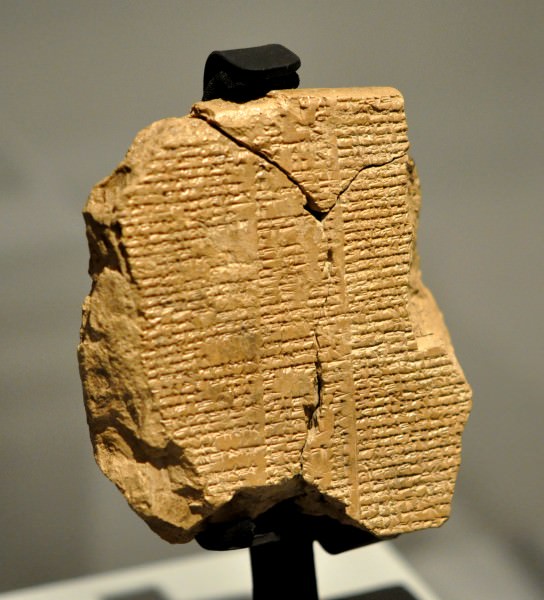
Part of Tablet V, the Epic of Gilgamesh
The first eleven tablets relate the standard version of the epic while the 12th tablet narrates an older Sumerian poem Bilgames and the Netherworld. Bilgames is another version of the name Gilgamesh but, as this tablet contradicts the story told in the first eleven, it is not included in most standard versions of the tale. Even so, with or without the twelfth tablet, the Epic of Gilgamesh is a stunning literary achievement which remains a best-seller thousands of years after it was written and confers upon its hero that which he sought throughout his story: immortality.
ORIGINS OF THE STORY
The Epic of Gilgamesh was originally a Sumerian poem, later translated into Akkadian, and first written down some 700 – 1000 years after the reign of the historical king of Uruk upon whom it is based. The poem was known originally as Sha-naqba-imru(He Who Saw The Deep) or, alternately, Shutur-eli-sham (Surpassing All Other Kings). The character was already developed in earlier Sumerian works as a great hero and demi-god, brother of the goddess Inanna, and a mighty warrior but, in the epic, he is transformed into the embodiment of the human struggle against death, loss, and the apparent meaningless of existence.
The author of the epic is Shin-Leqi-Unninni (whose name translates as `Moon god, accept my plea') a Babylonian scribe who wrote c. 1300-1000 BCE and has been cited as the first writer of literature in the western world even though that honor is rightly accorded to Enheduanna, daughter of Sargon of Akkad, who lived 2285-2250 BCE. Orientalist Samuel Noah Kramer points out that Shin-Leqi-Unninni did far more than simply translate and copy an earlier Sumerian work, he created something wholly new from older sources and this "something new" was the heroic epic ( History Begins at Sumer, 270). According to the scholar NK Sandars, the work is “the finest surviving epic poem from any period until the appearance of Homer's Iliad ;and it is immeasurably older”(Sandars, 7).
The hero of The Epic of Gilgamesh is the half-legendary King of Uruk who, according to the poem, felled the great trees of the Cedar Forest with his friend Enkidu to build the mighty gates of the city and journeyed far to find the secret of eternal life from the seer Utanapishtim. It is generally accepted that Gilgamesh was the historical 5th king who ruled in Uruk, widely regarded as the birthplace of writing in the west, circa 2500 BCE.
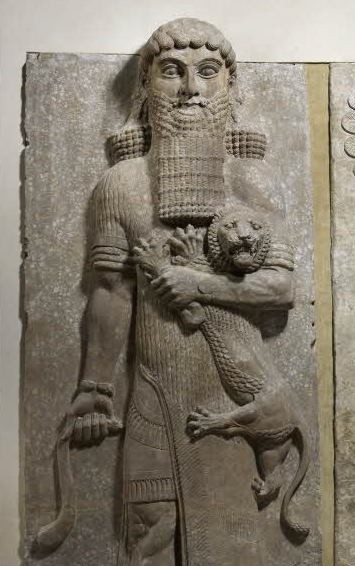
Hero Overpowering a Lion
Archaeological finds of letters and inscriptions attesting to his deeds, and those of his son, provide no reason to doubt such a man existed. In 2003 CE, in fact, a team of archaeologists claimed to have found Gilgamesh's tomb in the old riverbed of the Euphrates.
The deeds of this king were so great that, in time, the man was transformed from a mere mortal to a god. His father is said to have been the Priest-King Lugalbanda and his mother was the goddess Ninsun (also known as Rimat-Ninsun Ninsumun, the Holy Mother and Great Queen, whose name is interpreted as `August Cow' or `Wild Cow of the Enclosure') thus making Gilgamesh a demi-god of extraordinary endurance and strength but, also, mortal.
While Gilgamesh could, and did, perform many great feats, he could not finally realize his greatest desire to conquer death, to live eternally – or could he?
THE QUEST FOR ETERNAL LIFE
THE WILD MAN ENKIDU WHO WOULD BE A CHALLENGE TO GILGAMESH'S STRENGTH &, PERHAPS, TEACH HIM HUMILITY.
According to The Epic of Gilgamesh, the great king, arrogant and cruel among the lesser beings he ruled, was sent a strange gift from the gods: the wild man Enkidu who would be a challenge to Gilgamesh's strength and, perhaps, teach him humility.
Enkidu, originally without law and running wild in the forests, is seduced and thereby tamed by the temple harlot Shamhat, and is brought to Uruk where he, as intended, challenges Gilgamesh. After they fight, and Enkidu is bested, the two vow eternal friendship to each other and Gilgamesh's mother Ninsun adopts Enkidu as her own.
Following the battle of the Cedar Forest in which they defeat the demon Humbaba the terrible and, soon after, the Bull of Heaven (insulting the goddess Inanna- Ishtar along the way) the gods decree the death of Enkidu, claiming that someone must pay the blood price for such presumptuous deeds. Enkidu dies and, in that moment, Gilgamesh realizes that he, too, will die and this knowledge torments him.
He cries out:
How can I rest, how can I be at peace? Despair is in my heart. What my brother is now, that shall I be when I am dead. Because I am afraid of death I will go as best I can to find Utnapishtim whom they call the Faraway, for he has entered the assembly of the gods. (Sandars, 97)
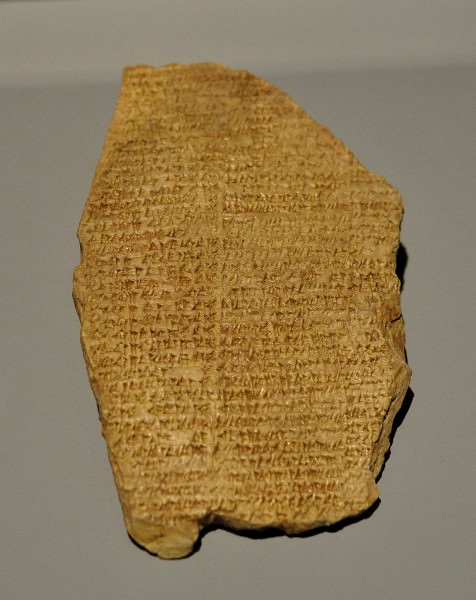
The Story of Gilgamesh and Aga
After a journey across the Land of Night and the Waters of Death, Gilgamesh finds the ancient man Utanapishtim, the only human being to survive the Great Flood who was, afterwards, granted immortality. Utanapishtim tells Gilgamesh the story of how he was warned by the god Ea of the coming deluge, followed his command to build an ark and place assorted animals inside and so save himself and his family from death and humanity from extinction.
He then tells Gilgamesh eternal life will be granted if the great king can stay awake for the next six days. Gilgamesh fails in this and fails in his next attempt (to bring back a magic plant which will make one young again. The plant is eaten by a snake while Gilgamesh sleeps; thus explaining why snakes shed their skins) and, having failed to win immortality, is brought back to Uruk by the ferryman Urshanabi where, once home, he writes down his great adventure.
According to the historian D. Brendan Nagle:
This magnificent poem, which deals with such eternal human problems as sickness, old age, death, fame and the craving for the unattainable, can be considered a metaphor for Mesopotamia's own heroic struggle to resist decay and leave a name for itself among the peoples of Earth. (16)
However true that may be, the epic is, at heart, the eternal struggle of the individual to find meaning in existence. Sandars writes:
If Gilgamesh is not the first human hero, he is the first tragic hero of whom anything is known. He is at once the most sympathetic to us, and most typical of individual man in his search for life and understanding. (7)
While Gilgamesh may have failed in his quest for immortality in the epic and the historical king is known only through passing references, lists and inscriptions, he lives on eternally through the work of Shin-Leqi-Unninni and the many other, now nameless, scribes who wrote down the orally transmitted tale and translated the story laboriously generation to generation.
These scribes attribute the original source of the story to Gilgamesh himself who, allegedly, inscribed his great deeds and adventures on a huge stone by the gates of Uruk. In the words of the anthropologist Gwendolyn Leick, Gilgamesh thus “became immortal by making a significant contribution to the greatness of his city by availing himself of the city's ultimate cultural invention: writing” (56).
Through the written word, the story of Gilgamesh and his pride, his grief for the loss of his loved friend, his fear of death and quest for eternal life, the great king does, in fact, conquer death and wins his immortality each time his tale is read.
LICENSE:
Article based on information obtained from these sources:with permission from the Website Ancient History Encyclopedia
Content is available under License Creative Commons: Attribution-NonCommercial-ShareAlike 3.0 Unported. CC-BY-NC-SA License